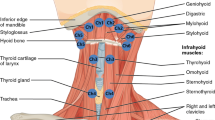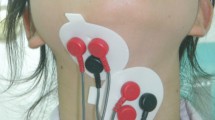Abstract
It is not known whether there are age- and/or gender-related differences in magnitude of motor-evoked potentials (MEPs) of the submental muscles. Knowledge of this is important in investigations of neurophysiological aspects of swallowing. Forty healthy participants (20 males, 20 females; 20 young [21–35 years], 20 old [53–88 years]) were recruited. Surface electromyography (EMG) electrodes were placed at midline underlying the submental muscle group. Age- and gender-related differences were evaluated in two neurophysiologic measures of swallowing: MEPs stimulated by single-pulse transcranial magnetic stimulation (TMS) over the motor cortex and surface electromyography (sEMG) recorded from the same submental muscle group during non-stimulated swallows. The older participants had larger MEPs during saliva swallowing than the young participants (p = 0.04, d = 0.86). Conversely, the older participants had lower amplitude submental EMG activity during non-stimulated swallows (p = 0.045, d = 0.67). Gender had no significant effect on MEP magnitude and on submental activity during saliva swallowing. There were no effects of age or gender on MEP latencies. These findings suggest deterioration in muscle function with age in a sample of healthy adults presenting with functional swallowing. We speculate that muscular decline is partially ameliorated by increased cortical activity—i.e., increased submental MEPs—so as to preserve swallowing function in healthy older subjects. These findings emphasize the need for different reference points for evaluation of submental MEPs of different age groups.


Similar content being viewed by others
References
Abdul Wahab N, Jones RD, Huckabee ML (2010) Effects of olfactory and gustatory stimuli on neural excitability for swallowing. Physiol Behav 101:568–575
Athukorala RP, Jones RD, Sella O, Huckabee ML (2014) Skill training for swallowing rehabilitation in patients with Parkinson’s disease. Arch Phys Med Rehabil 95(7):1374–1382
Bernard JA, Seidler RD (2012) Evidence for motor cortex dedifferentiation in older adults. Neurobiol Aging 33:1890–1899
Burden A (2010) How should we normalize electromyograms obtained from healthy participants? What we have learned from over 25 years of research. J Electromyogr Kinesiol 20:1023–1035
Butler SG, Stuart A, Leng X, Wilhelm E, Rees C, Williamson J, Kritchevsky SB (2011) The relationship of aspiration status with tongue and handgrip strength in healthy older adults. J Gerontol A Biol Sci Med Sci 66:452–458
Dodds WJ, Stewart ET, Logemann JA (1990) Physiology and radiology of the normal oral and pharyngeal phases of swallowing. AJR Am J Roentgenol 154:953–963
Doeltgen SH, Dalrymple-Alford J, Ridding MC, Huckabee ML (2010) Differential effects of neuromuscular electrical stimulation parameters on submental motor-evoked potentials. Neurorehabil Neural Repair 24:519–527
Doeltgen SH, Ridding MC, Dalrymple-Alford J, Huckabee ML (2011) Task-dependent differences in corticobulbar excitability of the submental motor projections: implications for neural control of swallowing. Brain Res Bull 84:88–93
Donner MW, Bosma JF, Robertson DL (1985) Anatomy and physiology of the pharynx. Gastrointest Radiol 10:196–212
Ertekin C, Aydogdu I (2003) Neurophysiology of swallowing. Clin Neurophysiol 114:2226–2244
Evans WJ (1995) What is sarcopenia? J Gerontol A Biol Sci Med Sci 50:5–8
Faulkner JA, Larkin LM, Claflin DR, Brooks SV (2007) Age-related changes in the structure and function of skeletal muscles. Clin Exp Pharmacol Physiol 34:1091–1096
Fling BW, Knight CA, Kamen G (2009) Relationships between motor unit size and recruitment threshold in older adults: implications for size principle. Exp Brain Res 197:125–133
Fraser C et al (2002) Driving plasticity in human adult motor cortex is associated with improved motor function after brain injury. Neuron 34:831–840
Fraser C, Rothwell J, Power M, Hobson A, Thompson D, Hamdy S (2003) Differential changes in human pharyngoesophageal motor excitability induced by swallowing, pharyngeal stimulation, and anesthesia. Am J Physiol Gastrointest Liver Physiol 285:G137–G144
Gleeson DC (1999) Oropharyngeal swallowing and aging: a review. J Commun Disord 32:373–395
Gooden BR, Ridding MC, Miles TS, Nordstrom MA, Thompson PD (1999) Bilateral cortical control of the human anterior digastric muscles. Exp Brain Res 129:582–591
Gur RC et al. (1991) Gender differences in age effect on brain atrophy measured by magnetic resonance imaging. Proc Natl Acad Sci U S A 88: 2845–2849
Hallett M (2000) Transcranial magnetic stimulation and the human brain. Nature 406:147–150
Hamdy S et al (1996) The cortical topography of human swallowing musculature in health and disease. Nat Med 2:1217–1224
Hamdy S, Aziz Q, Rothwell JC, Crone R, Hughes D, Tallis RC, Thompson DG (1997) Explaining oropharyngeal dysphagia after unilateral hemispheric stroke. Lancet 350:686–692
Hamdy S, Aziz Q, Rothwell JC, Power ML, Singh KD, Nicholson DA, Tallis RC et al. (1998) Recovery of swallowing after dysphagic stroke relates to functional reorganization in the intact motor cortex. Gastroenterology 115(5):1104–1112
Hamdy S, Mikulis DJ, Crawley A, Xue S, Lau H, Henry S, Diamant NE (1999) Cortical activation during human volitional swallowing: an event-related fMRI study. Am J Physiol 277:G219–G225
Hamdy S, Xue S, Valdez D, Diamant NE (2001) Induction of cortical swallowing activity by transcranial magnetic stimulation in the anaesthetized cat. Neurogastroenterol Motil 13:65–72
Humbert IA, Robbins J (2008) Dysphagia in the elderly. Phys Med Rehabil Clin N Am 19:853–866
Humbert IA et al (2009) Neurophysiology of swallowing: effects of age and bolus type. Neuroimage 44:982–991
Jaberzadeh S, Pearce SL, Miles TS, Turker KS, Nordstrom MA (2007) Intracortical inhibition in the human trigeminal motor system. Clin Neurophysiol 118:1785–1793
Johnson IP, Duberley RM (1998) Motoneuron survival and expression of neuropeptides and neurotrophic factor receptors following axotomy in adult and ageing rats. Neuroscience 84:141–150
Keenan KG, Farina D, Merletti R, Enoka RM (2006) Influence of motor unit properties on the size of the simulated evoked surface EMG potential. Exp Brain Res 169:37–49
Kern MK, Jaradeh S, Arndorfer RC, Shaker R (2001) Cerebral cortical representation of reflexive and volitional swallowing in humans. Am J Physiol Gastrointest Liver Physiol 280:G354–G360
Kidgell DJ, Pearce AJ (2010) Corticospinal properties following short-term strength training of an intrinsic hand muscle. Hum Mov Sci 29:631–641
Kleim JA, Jones TA (2008) Principles of experience-dependent neural plasticity: implications for rehabilitation after brain damage. J Speech Lang Hear Res 51:S225–S239
Koski L, Mernar TJ, Dobkin BH (2004) Immediate and long-term changes in corticomotor output in response to rehabilitation: correlation with functional improvements in chronic stroke. Neurorehabil Neural Repair 18:230–249
Langan J, Peltier SJ, Bo J, Fling BW, Welsh RC, Seidler RD (2010) Functional implications of age differences in motor system connectivity. Front Syst Neurosci 4:17
Livingston SC, Goodkin HP, Ingersoll CD (2010) The influence of gender, hand dominance, and upper extremity length on motor evoked potentials. J Clin Monit Comput 24:427–436
Logemann JA (1990) Effects of aging on the swallowing mechanism. Otolaryngol Clin North Am 23:1045–1056
Malandraki GA, Perlman AL, Karampinos DC, Sutton BP (2011) Reduced somatosensory activations in swallowing with age. Hum Brain Mapp 32:730–743
Martin RE, Goodyear BG, Gati JS, Menon RS (2001) Cerebral cortical representation of automatic and volitional swallowing in humans. J Neurophysiol 85:938–950
Martin RE, MacIntosh BJ, Smith RC, Barr AM, Stevens TK, Gati JS, Menon RS (2004) Cerebral areas processing swallowing and tongue movement are overlapping but distinct: a functional magnetic resonance imaging study. J Neurophysiol 92:2428–2443
Matsunaga K, Uozumi T, Tsuji S, Murai Y (1998) Age-dependent changes in physiological threshold asymmetries for the motor evoked potential and silent period following transcranial magnetic stimulation. Electroencephalogr Clin Neurophysiol 109:502–507
McGregor KM et al (2011) Physical activity and neural correlates of aging: a combined TMS/fMRI study. Behav Brain Res 222:158–168
Mittal KR, Logmani FH (1987) Age-related reduction in 8th cervical ventral nerve root myelinated fiber diameters and numbers in man. J Gerontol 42:8–10
Monfils MH, Plautz EJ, Kleim JA (2005) In search of the motor engram: motor map plasticity as a mechanism for encoding motor experience. Neuroscientist 11:471–483
Mosier K, Bereznaya I (2001) Parallel cortical networks for volitional control of swallowing in humans. Exp Brain Res 140:280–289
Mosier KM, Liu WC, Maldjian JA, Shah R, Modi B (1999) Lateralization of cortical function in swallowing: a functional MR imaging study. AJNR Am J Neuroradiol 20:1520–1526
Nicosia MA, Hind JA, Roecker EB, Carnes M, Doyle J, Dengel GA, Robbins J (2000) Age effects on the temporal evolution of isometric and swallowing pressure. J Gerontol A Biol Sci Med Sci 55:M634–M640
Peinemann A, Lehner C, Conrad B, Siebner HR (2001) Age-related decrease in paired-pulse intracortical inhibition in the human primary motor cortex. Neurosci Lett 313:33–36
Piron L, Piccione F, Tonin P, Dam M (2005) Clinical correlation between motor evoked potentials and gait recovery in poststroke patients. Arch Phys Med Rehabil 86:1874–1878
Pitcher JB, Ogston KM, Miles TS (2003) Age and sex differences in human motor cortex input-output characteristics. J Physiol 546:605–613
Power M et al (2004) Changes in pharyngeal corticobulbar excitability and swallowing behavior after oral stimulation. Am J Physiol Gastrointest Liver Physiol 286:G45–G50
Robbins J, Hamilton JW, Lof GL, Kempster GB (1992) Oropharyngeal swallowing in normal adults of different ages. Gastroenterology 103:823–829
Robbins J, Levine R, Wood J, Roecker EB, Luschei E (1995) Age effects on lingual pressure generation as a risk factor for dysphagia. J Gerontol A Biol Sci Med Sci 50:M257–M262
Robbins J, Gangnon RE, Theis SM, Kays SA, Hewitt AL, Hind JA (2005) The effects of lingual exercise on swallowing in older adults. J Am Geriatr Soc 53:1483–1489
Rossini PM, Desiato MT, Caramia MD (1992) Age-related changes of motor evoked potentials in healthy humans: non-invasive evaluation of central and peripheral motor tracts excitability and conductivity. Brain Res 593:14–19
Sowman PF, Flavel SC, McShane CL, Sakuma S, Miles TS, Nordstrom MA (2009) Asymmetric activation of motor cortex controlling human anterior digastric muscles during speech and target-directed jaw movements. J Neurophysiol 102:159–166
Suzuki T, Connor NP, Lee K, Bless DM, Ford CN, Inagi K (2002) Age-related alterations in myosin heavy chain isoforms in rat intrinsic laryngeal muscles. Ann Otol Rhinol Laryngol 111:962–967
Suzuki M, Asada Y, Ito J, Hayashi K, Inoue H, Kitano H (2003) Activation of cerebellum and basal ganglia on volitional swallowing detected by functional magnetic resonance imaging. Dysphagia 18:71–77
Svensson P, Romaniello A, Wang K, Arendt-Nielsen L, & Sessle BJ (2006) One hour of tongue-task training is associated with plasticity in corticomotor control of the human tongue musculature. Exp Brain Res 173(1):165–173
Tamura F, Kikutani T, Tohara T, Yoshida M, Yaegaki K (2012) Tongue thickness relates to nutritional status in the elderly. Dysphagia 27:556–561
Teismann IK, Steinstraeter O, Schwindt W, Ringelstein EB, Pantev C, Dziewas R (2010) Age-related changes in cortical swallowing processing. Neurobiol Aging 31:1044–1050
Vaiman M, Eviatar E, Segal S (2004) Surface electromyographic studies of swallowing in normal subjects: a review of 440 adults. Report 2. Quantitative data: amplitude measures. Otolaryngol Head Neck Surg 131:773–780
van Lunteren E, Vafaie H, Salomone RJ (1995) Comparative effects of aging on pharyngeal and diaphragm muscles. Respir Physiol 99:113–125
Wassermann, EM, Epstein, CM, & Ziemann, U (2008) The Oxford handbook of transcranial stimulation. Oxford Univ Press, New York
Acknowledgments
The work was supported by a research grant from Canterbury Medical Research Foundation.
Conflict of interest
The authors declare that there are no conflicts of interest.
Author information
Authors and Affiliations
Corresponding author
About this article
Cite this article
Sella, O., Jones, R.D. & Huckabee, ML. Age and gender effects on submental motor-evoked potentials. AGE 36, 9735 (2014). https://doi.org/10.1007/s11357-014-9735-z
Received:
Accepted:
Published:
DOI: https://doi.org/10.1007/s11357-014-9735-z




